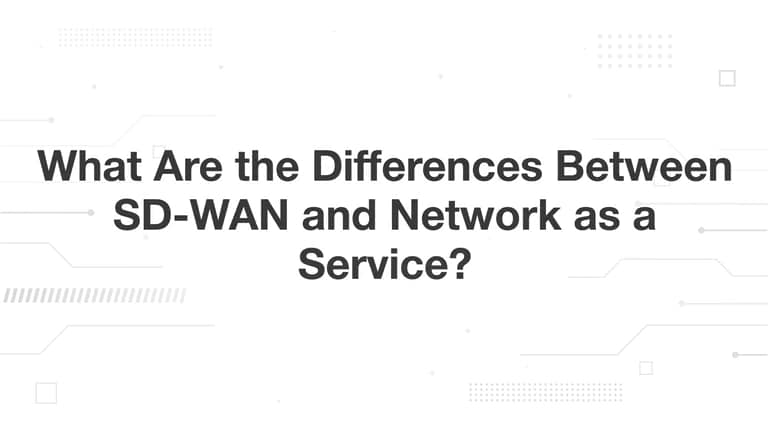-
Why Machine Learning (ML) and Artificial Intelligence (AI) Are Key Technologies for SD-WAN
- What Is WAN Optimization (WAN Acceleration)?
- What Is Secure SD-WAN? | What It Is and How It Works
- What Is SD-WAN as a Service (SD-WANaaS)?
-
What Is SD-WAN Security? | SD-WAN Security Considerations
- What are the main security challenges of SD-WAN?
- What are the primary SD-WAN security features?
- What is AI’s role in improving SD-WAN security?
- What is the role of SASE in SD-WAN security?
- Do next-generation SD-WAN solutions provide better security?
- What is the difference between SD-WAN security and secure SD-WAN?
- SD-WAN security FAQs
- What Is Next-Generation SD-WAN?
-
What Is Managed SD-WAN?
- How does managed SD-WAN work?
- What are the differences between DIY and managed SD-WAN?
- Why do businesses need managed SD-WAN?
- Types of managed SD-WAN deployments
- What are the pros and cons of managed SD-WAN?
- What is the difference between managed SD-WAN and SD-WAN as a service?
- How to choose the right deployment model: managed SD-WAN, DIY, or a combination
- What Is Hybrid SD-WAN?
-
Branch Network Security | Securing Branch Networks with SD-WAN
-
What Is an SD-WAN Appliance? | SD-WAN Hardware & Equipment
- How do SD-WAN appliances work?
- What are the different types of SD-WAN appliances?
- What are the different SD-WAN appliance deployment models?
- What are the benefits of SD-WAN appliances?
- What are the common features of SD-WAN appliances?
- Security considerations for SD-WAN appliances
- How to choose the right SD-WAN appliance for your needs
- SD-WAN appliance FAQs
-
What Is an SD-WAN Gateway? | Definition, Explanation, Use Cases
- What are the limitations of hub-and-spoke architecture?
- What is the purpose of an SD-WAN gateway?
- What are the primary SD-WAN gateway use cases?
- What are the features of an SD-WAN gateway?
- What are the different types of SD-WAN gateway form factors?
- What are the disadvantages of an SD-WAN gateway?
- SD-WAN gateway FAQs
-
Traditional WAN vs. SD-WAN: What Are the Differences?
- How did traditional WAN evolve into SD-WAN?
- What is a WAN?
- What is SD-WAN?
- What are the differences between SD-WAN and WAN?
- What are the similarities between SD-WAN and WAN?
- What makes SD-WAN a better choice over WAN?
- When is traditional WAN the right choice?
- How to choose between WAN and SD-WAN
- Traditional WAN vs. SD-WAN FAQs
-
Top 5 Requirements for Securing Your Branch Offices
-
What are the differences between SD-WAN and SDN?
- What is SD-WAN (software-defined wide area network)?
- What is SDN (software-defined networking)?
- Primary SD-WAN use cases
- Primary SDN use cases
- What are the benefits of SD-WAN?
- What are the benefits of SDN?
- What are the potential implementation challenges of SD-WAN?
- What are the potential implementation challenges of SDN?
- What are the differences between SD-WAN and SDN?
- What are the similarities between SD-WAN and SDN?
- How to choose between SD-WAN and SDN
- How Do 5G and SD-WAN Work Together?
- SD-WAN vs MPLS vs Internet: What’s the Difference? Which is Right for Your Organization?
-
Types of SD-WAN Deployment Models: A Complete Guide
- Understanding modern SD-WAN capabilities and options
- What is SD-WAN?
- Types of SD-WAN management models
- DIY SD-WAN
- Fully managed SD-WAN
- Co-managed SD-WAN, aka Hybrid
- Managed CPE SD-WAN
- SD-WAN as a Service (SD-WANaaS)
- Types of SD-WAN deployment architectures
- Hub-and-spoke
- Mesh
- Hybrid mesh
- Types of SD-WAN deployment environments
- On-premises SD-WAN
- Cloud-based SD-WAN
- Hybrid SD-WAN
- How to choose the right SD-WAN deployment option for your business
- SD-WAN deployment models FAQs
- Top 7 SD-WAN Challenges: SD-WAN Risks, Issues, & Solutions
- MPLS | What Is Multiprotocol Label Switching
-
How to Execute an MPLS to SD-WAN Migration Step-by-Step
- Why do organizations switch from MPLS to SD-WAN?
- How is SD-WAN a better alternative to MPLS?
- What are the options for migration from MPLS to SD-WAN?
- Should you use an MSP for your MPLS to SD-WAN migration?
- What are the MPLS to SD-WAN migration challenges you can expect?
- Is there a middle ground between MPLS and SD-WAN?
- If your organization is planning an MPLS to SD-WAN migration, is SASE worth considering?
- How to create a successful MPLS to SD-WAN migration plan
- MPLS to SD-WAN migration FAQs
- How much does SD-WAN cost?
- How Does SD-WAN Automation Simplify Network Operations?
- How SD-WAN helps Today’s IoT
-
What Is SD-WAN Multicloud?
SD-WAN vs. NaaS: What Are the Differences?
The difference between SD-WAN and NaaS is that SD-WAN uses software-defined networking to optimize WAN performance, while NaaS delivers network services as a subscription.
The purpose of SD-WAN is to establish control over traffic routing and enhance connectivity. In contrast, NaaS focuses on offloading infrastructure management to a provider.
While SD-WAN is a more established technology, NaaS is newer in the market. Together, they have the potential to work as complementary solutions.
SD-WAN and NaaS in the current network services market
The network services market continues to advance, with SD-WAN (software-defined wide area network) and NaaS (network as a service) playing key roles.
SD-WAN, which emerged in the early 2010s, revolutionized enterprise networks by improving application performance and reducing reliance on costly MPLS connections. The technology became even more critical during the COVID-19 pandemic to support the dispersed workforce’s connectivity needs.
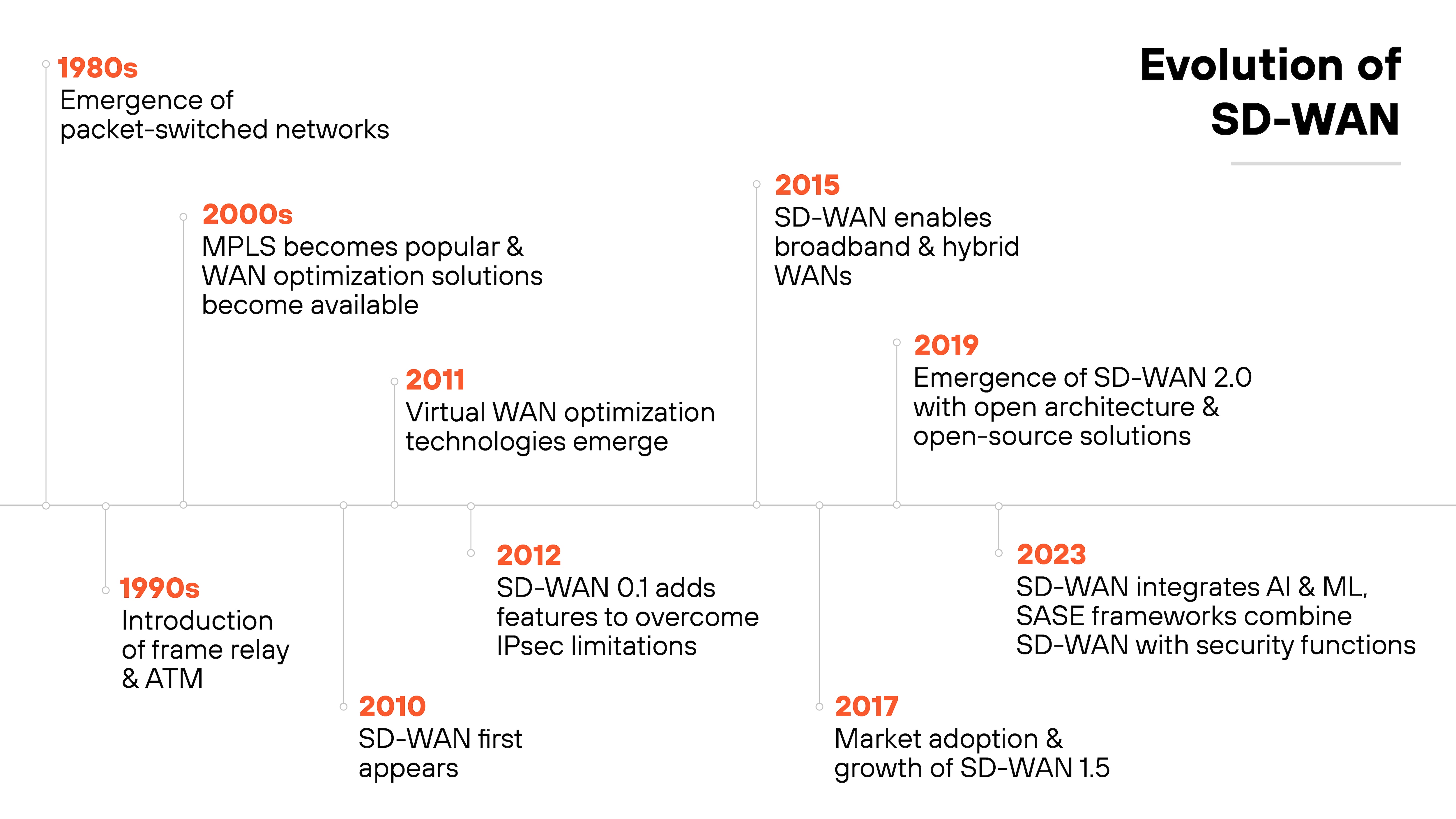
NaaS offers an alternative approach to network management by allowing enterprises to subscribe to network services rather than managing them in-house. The model offers agility, scalability, and cost-efficiency.
NaaS provides rented network infrastructure, management tools, and services from a centralized platform. Despite the vision for NaaS, it’s worth noting that the shift seems gradual. The market is still evaluating potential benefits and integration challenges.
However, both technologies have a common driver. Which is the need for more dynamic network solutions. Modern organizations have to support digital business, remote work environments, and increased security demands.
NaaS adoption may be especially appealing to network practitioners who are looking to overcome particular traditional WAN limitations. It’s helpful in eliminating inflexibility and high costs—plus, supporting evolving network edges.
At the same time, transitioning to NaaS involves navigating several challenges, including: security concerns, dependency on service providers, and integration complexities with existing IT ecosystems.
SD-WAN remains a tested, essential solution for businesses that need robust, configurable network solutions. Its ability to prioritize traffic and enhance connectivity without reliance on a single service provider makes SD-WAN indispensable for the long term.
What is SD-WAN?
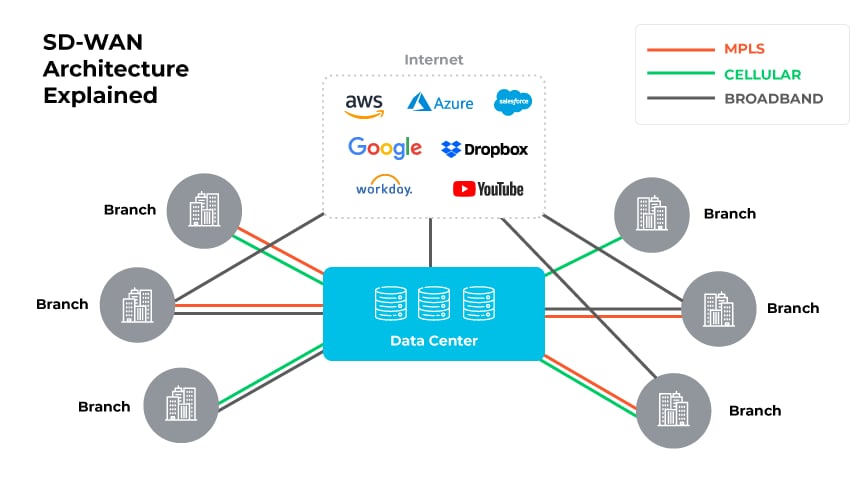
SD-WAN, or software-defined wide area network, is a networking technology that uses software-defined networking (SDN) principles to enhance the management and performance of wide area networks.
The technology facilitates more efficient data, application, and user connectivity across multiple locations. By centralizing control and visibility, SD-WAN boosts performance and reliability. It also simplifies the management of network complexities.
SD-WAN operates using virtualized services that can cover large geographical areas.
SD-WAN uses different types of connections, like MPLS, broadband, LTE, and VPNs, to easily connect branch offices and remote users to corporate resources.
Unlike traditional WANs that rely heavily on manual configurations and physical hardware, SD-WAN offers a more flexible solution. It enables dynamic traffic management and network adaptation through centralized software controls. This results in majorly improved speed, security, and network management efficiency.
Common use cases for SD-WAN include:
- Connecting branch offices
- Remote sites
- Optimizing cloud application performance
- Improving connectivity for IoT devices
- Providing secure, scalable network solutions for businesses of all sizes
What is NaaS?
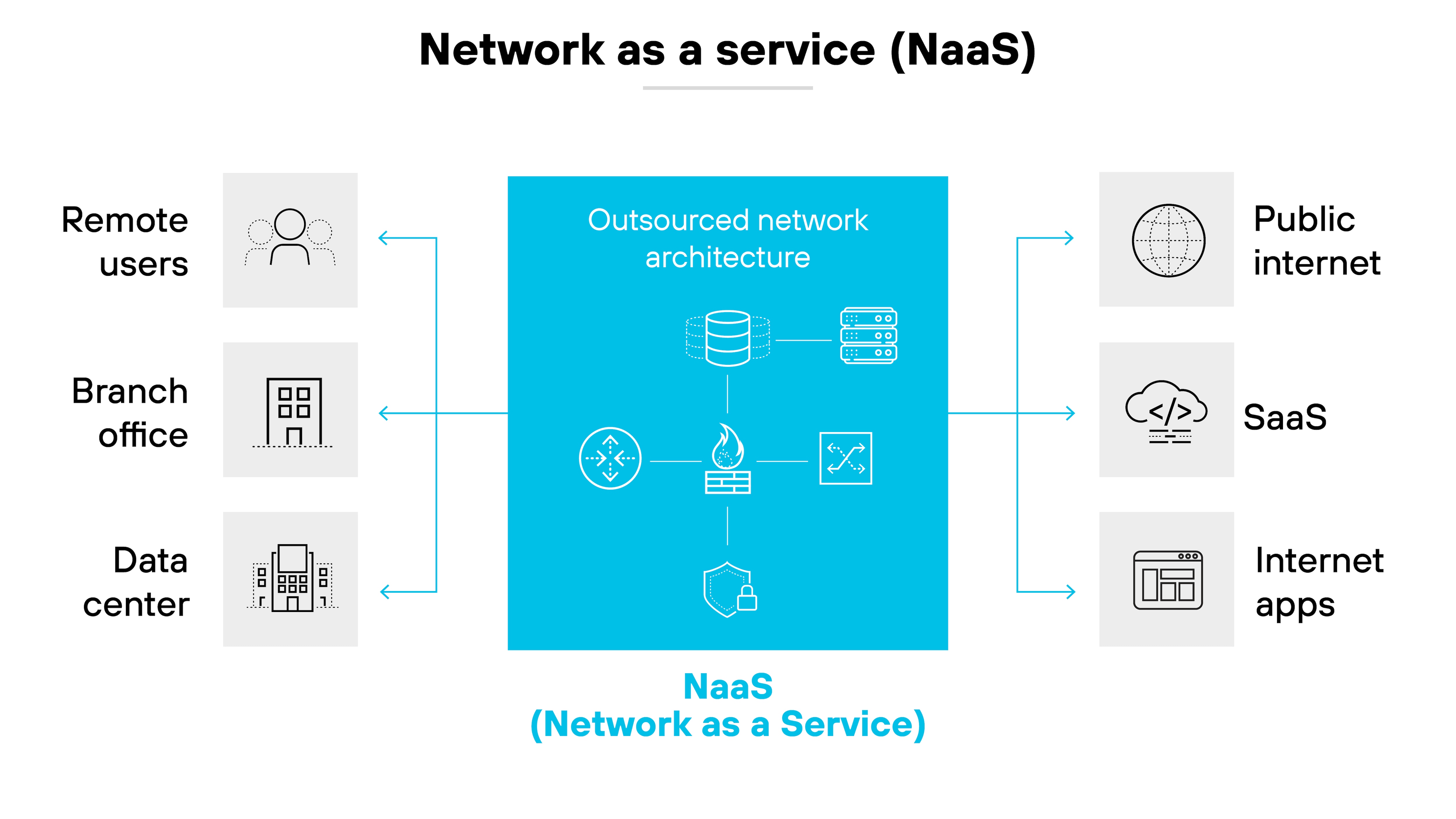
Network as a service (NaaS) is a cloud-delivered network infrastructure service that provides a flexible way to access and manage network services.
With a cost-effective, scalable, and subscription-based model, NaaS allows organizations to operate more agilely, accelerate innovations, and improve performance. It’s delivered via managed service, PaaS, or IaaS.
NaaS originally emerged in response to the need for cost-effective, flexible network infrastructure. In the past, enterprises had to invest heavily in physical networking infrastructure and specialized IT personnel—which are expensive and time-consuming.
In essence, NaaS works by eliminating the need for organizations to procure, deploy, and manage network infrastructure. Businesses purchase a subscription that provides access to the provider's network resources.
A NaaS subscription can include: managed services, rented hardware, or outsourcing complete operations such as deployment, management, and day-to-day operations.
Common use cases for NaaS include:
- Overall outsourced network operations
- Scalable bandwidth on demand (BoD)
- Automatic failover and disaster recovery
- Application prioritization via bandwidth management
- Remote network management via NFW
What are the differences between SD-WAN and NaaS?
| Parameters | SD-WAN vs. NaaS: What are the differences? | NaaS |
|---|---|---|
| Architecture | Centralized control for WANs using MPLS, broadband, LTE, optimizing with software-defined principles. | Complete network solution delivered as a service, including tools like VPNs, load balancers, firewalls. |
| Management | Direct control over network paths and policies, suitable for high control needs. | Outsources network management, focusing on core functions without daily operations. |
| Scalability | Scalable solutions but requires additional hardware or software configuration as needs grow. | Key feature, easily expand or reduce services based on current needs without new hardware. |
| Cost structure | Involves upfront hardware and software costs plus ongoing maintenance expenses. | High flexibility and scalability |
| Suitable for | Businesses with limited IT resources | Subscription-based model, lowering initial costs and spreading expenses over time. |
While both SDN and SD-WAN are software-defined networking technologies, they differ in network architecture, deployment scenarios, management and control, security features, and programmability.
The differences between SDN and SD-WAN make each technology suitable for specific use cases and organizational needs.
Architecture
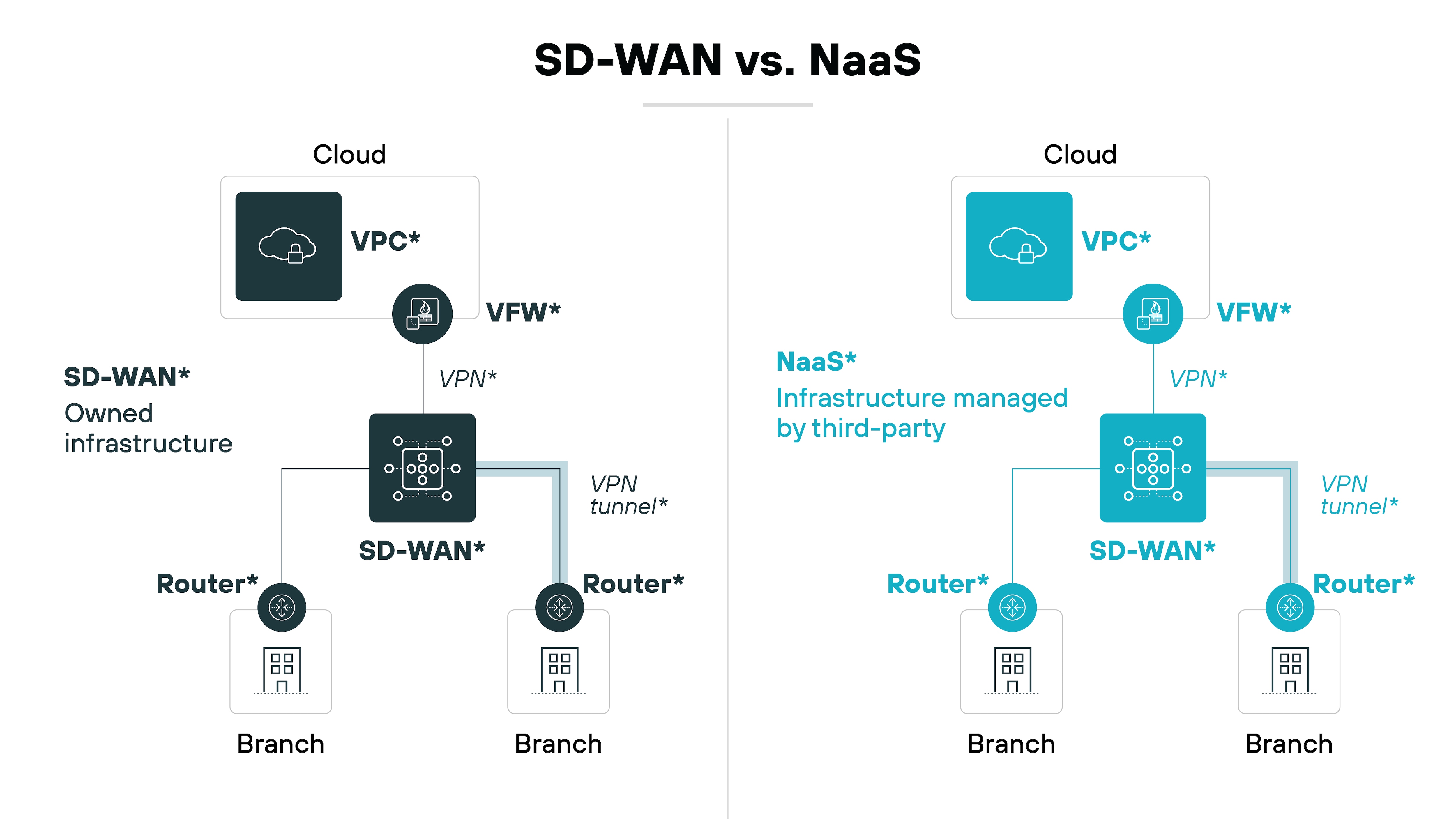
SD-WAN architecture uses a centralized control function to manage traffic across wide area networks, utilizing a combination of connections to optimize and secure data flow. The architecture focuses on improving connectivity by applying software-defined networking principles directly to WAN connections.
In contrast, NaaS provides a complete network solution delivered as a service from the cloud which includes various networking tools and services.
Management
SD-WAN gives organizations direct control over their networking paths and policies with tools to adjust settings based on network conditions in real time. The hands-on approach works well for organizations who need to maintain high levels of control over network traffic.
NaaS, however, abstracts much of the network management complexity by outsourcing it to service providers. That way, businesses can focus on core functions without the need to manage day-to-day network operations.
Scalability
SD-WAN provides scalable solutions, but usually requires additional hardware or software configuration as network demands grow.
NaaS offers scalability as a key feature. Customers can easily expand or reduce services based on current business needs—but without the logistical challenges of deploying new hardware or extensive configuration. All thanks to its cloud-based model.
Cost structure
The cost structures of SD-WAN and NaaS are fundamentally different.
SD-WAN may involve upfront costs for hardware and software, plus ongoing expenses for maintenance and network management.
NaaS, on the other hand, typically operates on a subscription-based model that can lower initial capital expenditures and spread costs over time. This model works well for organizations who are focused on reducing large capital investments.
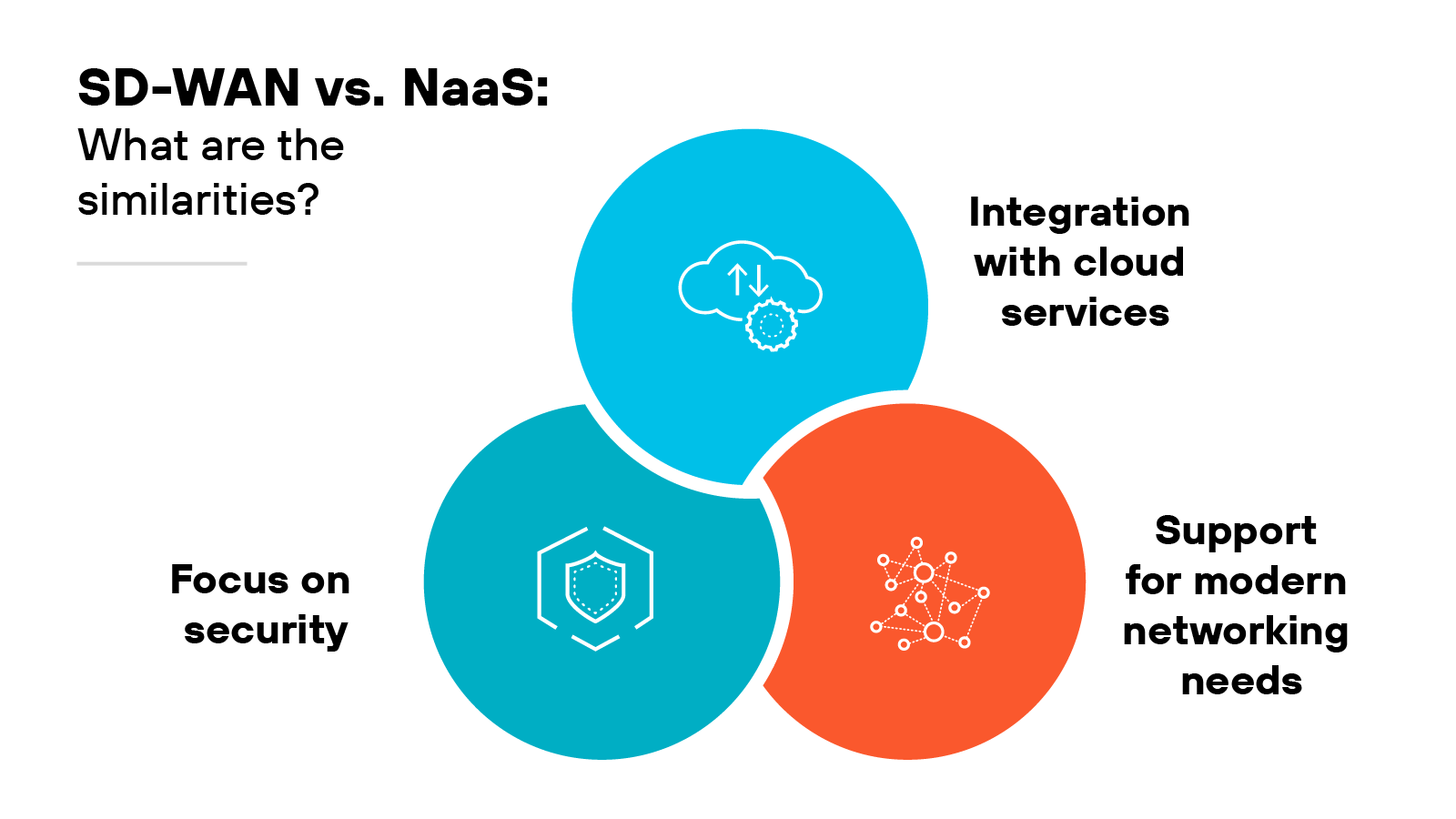
Integration with cloud services
Both SD-WAN and NaaS use cloud-based technologies to enhance network flexibility and scalability.
SD-WAN simplifies WAN management by using software to control the flow of traffic across a wide area network. High-end SD-WAN solutions integrate with cloud computing services to optimize connectivity and performance.
Similarly, NaaS provides network services through a cloud computing platform. That allows businesses to consume networking infrastructure on-demand without the headaches of traditional network management.
Focus on security
SD-WAN and NaaS both strongly emphasize network security.
SD-WAN integrates security functionalities directly into the network fabric. Features like encryption, firewalls, and microsegmentation protect data in transit across various connections.
NaaS focuses on delivering network connectivity and functionality as a service. Security features might be included as part of the service offering, but the specific features and level of control can vary depending on the provider.
Support for modern networking needs
Both technologies support the evolving requirements of modern enterprises: remote work, increased data consumption, etc.
SD-WAN and NaaS offer solutions that address the need for more dynamic, flexible, scalable network infrastructures.
And they both support distributed workforces with high volumes of cloud-based traffic. Which makes both technologies suitable for businesses looking to modernize network operations.
Further reading:
Will NaaS replace SD-WAN?
No, NaaS will not replace SD-WAN. Instead, the relationship between SD-WAN and NaaS is evolving into a more integrated solution.
Right now, organizations are interested in NaaS largely because of its flexibility and comprehensive service model. At the same time, SD-WAN remains a crucial component within many NaaS offerings, often provided as a managed service.
Hybrid adoption suggests that while NaaS may change how SD-WAN is consumed, it doesn’t eliminate the need for SD-WAN technologies. Companies are increasingly opting for NaaS platforms that include managed SD-WAN services, allowing them to enjoy the benefits of both technologies.
The integration of SD-WAN into NaaS solutions will likely continue to grow, facilitated by the broader adoption of secure access service edge (SASE) frameworks.
Further reading: SD-WAN vs. SASE: What’s the Difference?
How can SD-WAN and NaaS work together?
Today, SD-WAN and NaaS are complementary solutions that can drive business value when integrated effectively.
As mentioned, SD-WAN focuses on optimizing wide area network connections. It provides enhanced control and visibility across multiple locations. It also addresses specific connectivity issues like network congestion and packet loss. Which all adds up to reliable, secure connections that are necessary for business operations.
On the other hand, NaaS offers a broader, more flexible approach to network management. It provides a platform for consuming network infrastructure as a cloud-delivered service.
Which means:
Together, SD-WAN and NaaS can offer a strong framework for streamlining network operations.
For example: By integrating SD-WAN's detailed traffic management capabilities with NaaS's scalable infrastructure model, businesses can achieve a responsive, adaptable network environment. The integration would allow for the intelligent routing of network traffic, plus the rapid scaling and deployment of network resources as needed.
What is the future of SD-WAN and NaaS?
The future of SD-WAN and NaaS as a combined solution is unclear. On its own, the SD-WAN technology market is growing productively and continues to answer the demand for unified networking and security capabilities. The future of NaaS, however, isn’t as well-defined. The landscape continues to evolve, with new solutions emerging frequently.
The SD-WAN market is experiencing rapid growth and maturation because of the increasing demand for flexible, cloud-based networking solutions.
"By 2026, 60% of new SD-WAN purchases will be part of a single-vendor secure access service edge (SASE) offering, up from 15% in 2023. By 2026, generative AI technology embedded in SD-WAN offerings will be used for 20% of initial network configuration, up from near zero in 2023."
-Gartner, Inc., 2023 Gartner® Magic Quadrant™ for SD-WAN
According to the 2023 Gartner® Magic Quadrant™ for SD-WAN, the SD-WAN market is forecast to generate a compound annual growth rate (CAGR) in end-user spending of 14.6% from 2022 through 2027.
Not to mention, the integration of advanced technologies like artificial intelligence (AI) and machine learning (ML) into SD-WAN solutions is expected to enhance network management, uptime, and performance.
Where NaaS is concerned, AI-integrated solutions continue to crop up, often emphasizing network automation and self-healing capabilities.
Software-defined networking within the NaaS model, referred to as SDNaaS, is another industry trend. The industry may see specialized NaaS solutions emerging to meet the unique requirements of various industries, including healthcare, warehousing, smart factories, and manufacturing.
On the other hand:
“Although NaaS package offerings are still in a nascent phase (see What Is NaaS, and Should I Adopt It?), we believe that product managers should focus on these four major customer personas and the values that these personas care about,” notes Gartner (Early NaaS Pricing Lessons to Drive Adoption, April 27, 2023, Marissa Schmidt, Naresh Singh ).
So, NaaS remains an intriguing but developing technology. Time will tell how it will shape the future of network services.
Also:
“There is much commercial hype in the industry around network as a service but with significant differences on what it means. Communication service providers that sell enterprise network services cannot neglect this trend, and need to build and differentiate their NaaS offerings,” Gartner reported (Market Trend: CSP NaaS Offerings for Enterprise Networking, June 13, 2024, Gaspar Valdivia, Ted Corbett).
Though no one knows for sure how NaaS will evolve, its integration with SD-WAN could lead to more sophisticated, industry-specific solutions that apply the strengths of both technologies.
For example: The merging of SD-WAN's robust connectivity options with NaaS’s cloud-driven scalability could offer businesses a more adaptable network infrastructure capable of supporting dynamic business needs without the complexity of traditional setups.
Overall, the trajectory for SD-WAN and NaaS suggests a shift towards more integrated, user-friendly network services that cater to the increasing demands for flexibility, security, and efficiency in enterprise networking.
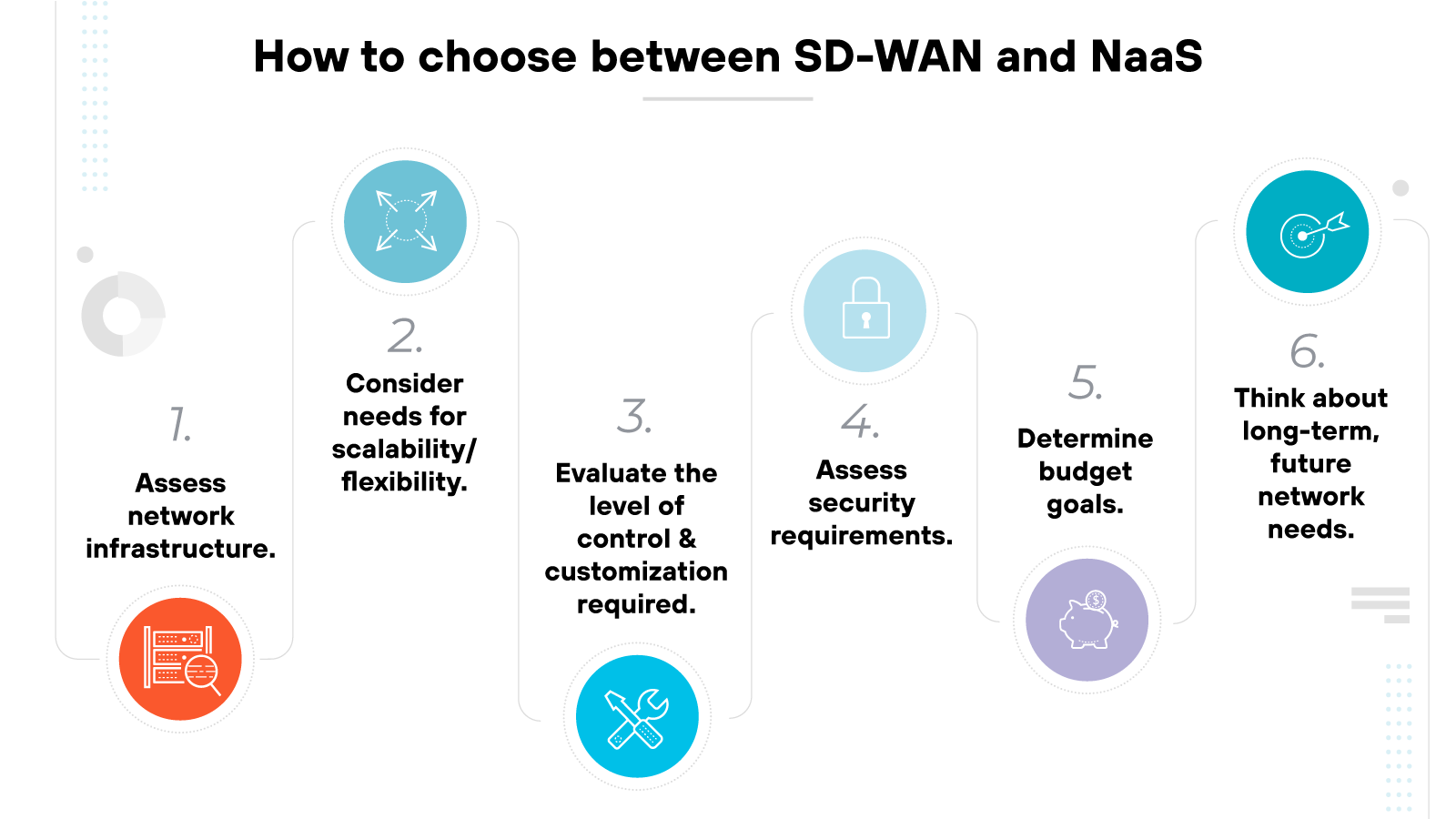
Choosing between SD-WAN and NaaS depends on your organization's specific needs, goals, and existing infrastructure.
If your organization is looking to optimize existing WAN performance with significant control and customization, SD-WAN may be the better choice. If you prefer a managed network service model that minimizes hardware dependencies and adapts easily to future needs, NaaS could be more suitable.
Here’s how to make an informed decision:
1. Assess your current network infrastructure.
SD-WAN is ideal for organizations that need to enhance existing WAN infrastructure. It uses multiple connection types to optimize performance and ensure reliability.
On the other hand, NaaS is a more comprehensive solution that abstracts physical network infrastructure management, providing network services through a subscription model.
2. Consider your organization’s need for scalability and flexibility.
SD-WAN allows for better bandwidth utilization and easy scalability by managing traffic across multiple connections. Which is beneficial for growing businesses who need efficient resource allocation.
NaaS, however, offers more flexibility without the need to manage hardware. This is especially useful for organizations aiming to reduce their hardware footprint and focus on core business operations.
3. Evaluate the level of control and customization required.
SD-WAN provides granular control over traffic routing and policy enforcement. This is a major boon for organizations with specific network performance and security requirements.
Again, NaaS offers a managed service model, so the provider handles network management. This works well for organizations who want to lean on expert management and possibly reduce internal IT workload.
4. Assess security requirements.
SD-WAN built-in security features like firewalls, intrusion prevention, and data encryption. This is ideal if you require a highly customizable and integrated security solution within your WAN. It’s worth noting, though, that managing these features usually requires internal security expertise.
NaaS provides pre-configured security features with varying levels of control depending on the provider. This simplifies management but may not offer the same level of customization as SD-WAN. NaaS can be a good fit if you prioritize ease of management and prefer to outsource security to a managed service provider.
5. Determine budget goals.
SD-WAN can reduce costs by optimizing the use of cheaper broadband connections alongside MPLS. But it still requires investment in hardware and management resources.
NaaS, with its subscription-based model, can offer predictable operating expenses and reduce capital expenditures by eliminating the need for significant hardware investments.
6. Think about long-term, future network needs.
Both SD-WAN and NaaS support future-proofing but in different ways.
SD-WAN optimizes WAN performance and scalability, allowing your network to adapt to changing needs and technologies. Which means the network can easily incorporate new technologies and handle increased data traffic as the organization grows.
NaaS, in contrast, offloads network management to the provider. This way, the network can easily adapt to future technological changes without requiring hardware upgrades.
TIP
Many vendors offer free trials, so test your options before making a decision. Trials can help determine which solution best fits your needs by providing hands-on experience with the technology.
Assessing your specific requirements and strategic goals will guide you in making the best decision between SD-WAN and NaaS.
